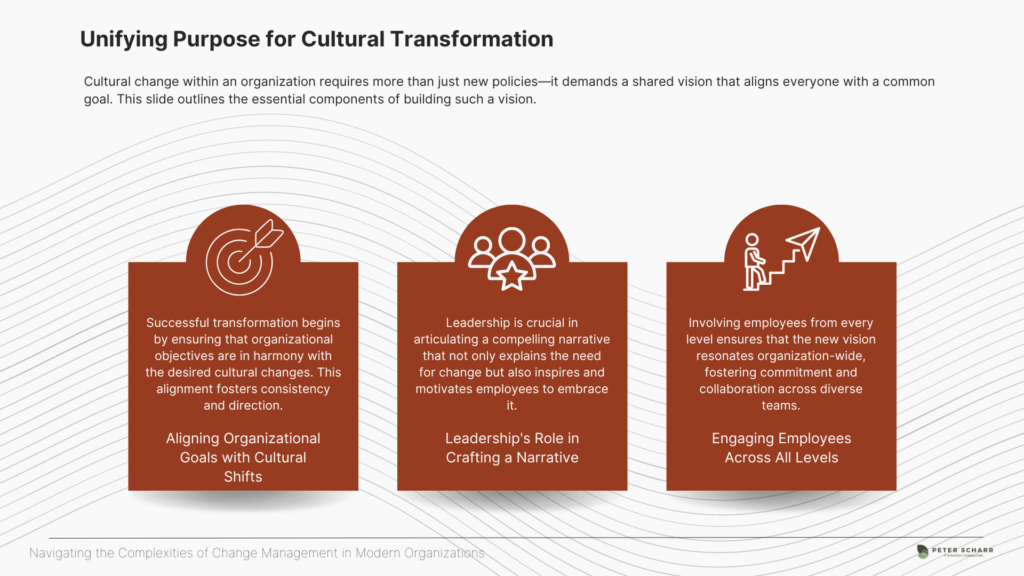Understanding Cultural Resistance – Why Change Often Faces Pushback
Change management can be a challenging process, especially when it comes up against the deeply ingrained cultural resistance within an organization. It’s not uncommon for employees and even leaders to resist change, even if the proposed changes are ultimately beneficial. But why does this happen? To navigate these waters effectively, it’s important to understand the deep roots of cultural pushback and how to address it in a way that promotes acceptance rather than conflict.
Psychological Reasons for Resistance
At the core of many resistance efforts is a simple truth: people don’t like uncertainty. Change, by its very nature, introduces unpredictability. Employees may worry about how new practices will affect their job security, workload, or even their sense of belonging within the company. This fear triggers psychological resistance, leading individuals to cling to the familiar, even if the familiar isn’t ideal. Leaders need to recognize these emotional responses early on and address them with empathy. Open communication strategies, like town halls or regular updates, can help alleviate anxiety by reassuring employees that their concerns are being heard and addressed.
Historical and Operational Barriers
Many organizations have long-standing traditions and processes that, over time, become intertwined with their identity. When change threatens these traditions, resistance can be fierce. For example, in a company that has always operated with a rigid hierarchical structure, introducing a more collaborative work model might be seen as an attack on its operational foundation. Leaders must therefore be sensitive to the historical context of their organization’s culture and consider how to respect, rather than dismantle, these traditions while still moving forward.
Recognizing Early Signs of Resistance
One of the most effective strategies in managing cultural resistance is recognizing it early. This can show up in various ways, such as employees becoming disengaged, increased absenteeism, or passive-aggressive comments during meetings. When you spot these warning signs, don’t ignore them. Instead, engage directly with your teams. Ask for feedback—what are their concerns? What do they see as the benefits or drawbacks of the proposed changes? By addressing resistance head-on, you can prevent minor issues from evolving into full-blown barriers to progress.
The Role of Cultural Awareness in Strategy
As explained before, understanding the culture of your organization is critical to creating strategies that are effective and sustainable. Leaders who are culturally aware don’t just impose changes; they craft strategies that align with the values, traditions, and unique characteristics of their organization. This minimizes friction and fosters a smoother transition. By acknowledging cultural resistance and addressing the underlying causes, leaders can turn obstacles into opportunities for growth.
Ultimately, the key to successful change management is recognizing that resistance is not a roadblock, but a valuable indicator of where attention is needed. It’s about working with your organization’s culture—not against it.
Building a Shared Vision – Aligning Goals with Cultural Shifts
As explained earlier, resistance to change often stems from uncertainty and fear of the unknown. But there’s a powerful way to counter this: creating a *shared vision*. When everyone in the organization understands not just what is changing, but why it’s changing, they can begin to see themselves as part of the journey. This sense of shared purpose can reduce anxiety and increase buy-in at all levels.

Building a shared vision isn’t just about crafting a catchy slogan or setting ambitious goals. It’s about aligning the organization’s objectives with a cultural shift that resonates deeply with the employees. A successful cultural transformation hinges on the ability of leadership to communicate a compelling narrative that unites the workforce around a common direction.
The Role of Leadership in Crafting the Vision
Leadership plays a central role in shaping and sharing the vision for cultural change. It’s not enough for leaders to say, “We’re making changes.” They need to articulate *why* these changes are happening and how they will benefit both the organization and its people. The process should feel collaborative rather than top-down.
One effective technique is to use storytelling to explain the need for change. For instance, sharing a success story from another organization that underwent a similar transformation can make the vision more relatable. Leaders can point to case studies, such as how McKinsey’s insights on change management helped companies successfully navigate cultural shifts by creating strong narratives that connected the dots for employees.
Engaging Employees at All Levels
One of the biggest mistakes organizations make during cultural change is focusing too much on leadership and assuming the rest of the workforce will naturally follow. However, real engagement happens when employees at *all levels* are brought into the process, not just upper management.
For example, holding interactive workshops or focus groups can give employees a voice in shaping the new direction. When employees feel they’ve contributed to the change, they’re more likely to embrace it. This is especially true in diverse teams where different departments or demographics may experience the change differently. Leaders should not only invite feedback but also act on it, demonstrating that employee input is valued and incorporated into the evolving vision.
Making the Vision Inclusive and Relevant
A shared vision will only succeed if it resonates with the entire organization. This means tailoring the message to address the needs and concerns of various groups within the company. A one-size-fits-all approach rarely works. For instance, the concerns of a sales team might differ significantly from those of the IT department, so leaders must be ready to adapt the message accordingly.
Inclusivity also means acknowledging the diverse cultural backgrounds and working styles in your organization. As noted in Harvard Business Review’s article on inclusive cultures, organizations that take the time to understand and incorporate diverse perspectives tend to experience smoother transitions and greater employee satisfaction. By ensuring the new direction is meaningful to everyone, not just a select few, leaders can foster a truly united workforce.
Conclusion: A Unified Effort for Lasting Change
Ultimately, building a shared vision is about creating a cultural shift that aligns with the organization’s goals while engaging employees at all levels. Leadership must craft a compelling narrative that not only explains the „what“ and „how“ of the changes but also the „why.“ By involving employees in the process and ensuring the vision resonates across the board, cultural change becomes a collaborative effort, laying the foundation for lasting success.
Measuring and Sustaining Change – How to Make Cultural Shifts Stick
As we’ve discussed, change isn’t easy—whether it’s facing resistance or crafting a shared vision. But perhaps the most challenging part is ensuring that the change sticks. Cultural evolution isn’t a one-time event; it’s a continuous process that requires ongoing attention. So how do organizations measure the effectiveness of their efforts and, just as importantly, sustain that momentum over time?
Tracking Progress with Key Performance Indicators (KPIs)
One of the first steps in evaluating your cultural change initiative is identifying the right Key Performance Indicators (KPIs). KPIs are measurable values that indicate how effectively an organization is achieving its objectives. In the context of cultural change, this could include metrics like employee engagement, retention rates, or levels of collaboration across departments.
For example, if one of your goals is to foster a more collaborative work environment, you might track how frequently cross-functional teams are meeting or the number of successful projects completed by diverse groups. Regularly reviewing KPIs helps leadership see whether the cultural shift is taking hold and allows for adjustments if progress stalls.
Creating Feedback Loops to Adjust Course
No plan is perfect, and that’s why feedback loops are crucial. These loops allow organizations to collect input from employees, assess the impact of changes, and adapt as needed. As mentioned in the previous section, engaging employees at all levels is essential, and this engagement should continue even after the initial changes are made. Establishing mechanisms like surveys, performance reviews, or focus groups helps keep the pulse on how the cultural change is being perceived and experienced.
For instance, if employees in one department feel left out of the process or are struggling to adapt, this feedback can be invaluable in preventing deeper issues from festering. A good example is how companies like Bain & Company use regular feedback cycles to refine their change management strategies, ensuring that their plans are flexible and responsive to real-time challenges.
Embedding New Practices into Everyday Routines
For a cultural shift to be truly successful, new practices must become part of the day-to-day routine. This requires more than just initial training or workshops; it means consistently reinforcing the new behaviors and mindsets that align with the cultural evolution. Leaders need to model these changes and recognize employees who embrace them. Providing incentives or public recognition for those who actively contribute to the new cultural direction can help solidify these changes as the new „normal.“
Embedding change also means ensuring the right tools and resources are available. If employees are expected to collaborate more, for example, investing in communication platforms like Slack or Microsoft Teams can help facilitate this. The goal is to make the new way of working as seamless as possible so that it doesn’t feel like an added burden but rather a natural part of the workflow.
Maintaining Momentum Over Time
Initial excitement around a cultural change can fade quickly if the momentum isn’t sustained. This is where consistent leadership and regular check-ins play a crucial role. Leaders should continue to communicate the long-term vision and celebrate both small and large milestones along the way. Employee recognition programs, ongoing learning opportunities, and regular updates on progress can all help keep the energy alive.
Furthermore, it’s important to remain flexible. As the organization evolves, new challenges will emerge, and the cultural change process will need to adapt. Leaders must be prepared to revisit the original goals and make necessary adjustments to ensure the cultural shift remains relevant and aligned with the organization’s evolving needs.
Conclusion: Change Isn’t an Event, It’s a Journey
Sustaining cultural change requires continuous effort, attention, and adaptability. By measuring progress with KPIs, leveraging feedback loops, embedding new practices, and maintaining momentum, organizations can ensure that the changes they implement become a lasting part of their culture. The journey may not always be smooth, but with the right tools and mindset, cultural evolution can be a powerful force for long-term success.
Change is an ongoing process—embrace it, guide it, and nurture it,


